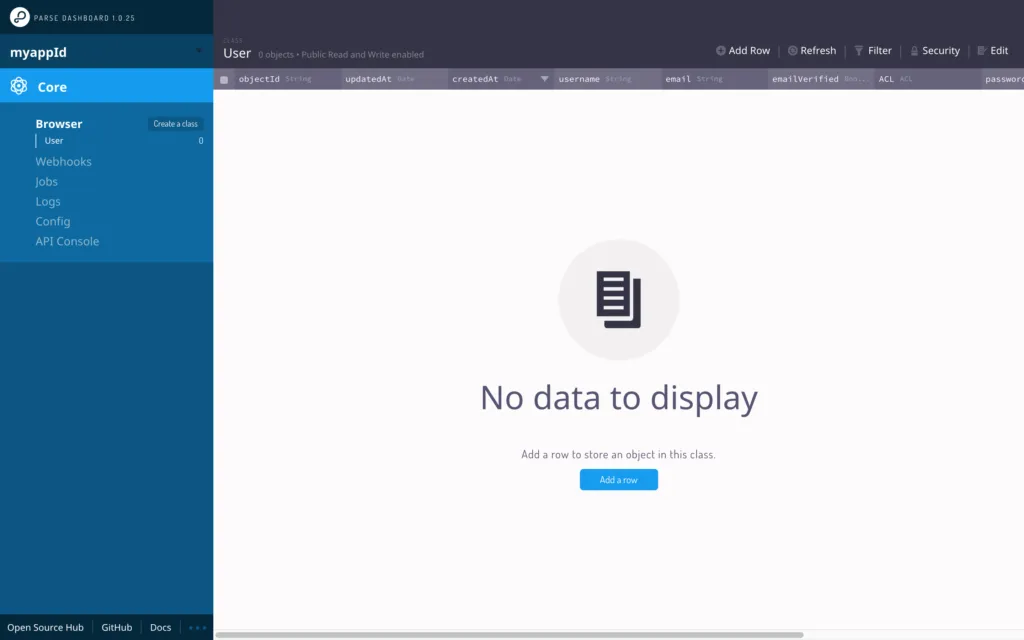Parse is a well-known open source Mobile Backend-as-a-Service
If you haven't seen the previous post on how to run Parse Server on OpenShift, please take a look Parse Server on OpenShift Online (Next Gen).
Here, I'll focus more on dashboard and Parse Server integration. Running Parse mobile backend on OpenShift has been greatly simplified and made available in a few commands.
Note: If you're using self-signed certs for your router, then you need to accept them for the dashboard URL and Parse Server URL, otherwise you may see issues.
Create a Namespace and Provide Appropriate Permissions
$ oc new-project parse
$ oc adm policy add-scc-to-user anyuid -z default -n parse
$ oc adm policy add-scc-to-user privileged -z default -n parse
Importing Parse Server Example Template
$ oc create -f https://raw.githubusercontent.com/parse-community/parse-server-example/master/openshift.json
$ oc new-app parse-server-example -e APP_ID=myappid -e MASTER_KEY=supersecret
$ oc patch route/parse-server-example -p '{"spec":{"tls": {"termination":"edge"}}}'
$ oc get routes -l app=parse-server-example -o jsonpath='{.items[*].spec.host}'
$ PARSE_SERVER_URL=$(oc get routes -l app=parse-server-example -o jsonpath='{.items[*].spec.host}')
$ PARSE_SERVER_URL='https://'$PARSE_SERVER_URL'/parse'
$ oc volume dc/mongodb --remove --name mongodb-data #incase you dont have persistent volume
Deploy Parse Dashboard
$ oc project parse
$ oc new-app https://github.com/parse-community/parse-dashboard.git \
-e PARSE_DASHBOARD_ALLOW_INSECURE_HTTP=true \
-e PARSE_DASHBOARD_SERVER_URL=$PARSE_SERVER_URL \
-e PARSE_DASHBOARD_MASTER_KEY="supersecret" \
-e PARSE_DASHBOARD_APP_ID="myappid" \
-e PARSE_DASHBOARD_APP_NAME="MyApp" \
-e PARSE_DASHBOARD_USER_ID="user1" \
-e PARSE_DASHBOARD_USER_PASSWORD="pass"
$ oc expose dc parse-dashboard --port=4040
$ oc expose svc parse-dashboard
$ oc patch route/parse-dashboard -p '{"spec":{"tls": {"termination":"edge"}}}'
$ oc get routes
How to Use?
Open the the dashboard URL and use the following credentials for logging into the Parse Dashboard: user1/pass

Conclusion
You can deploy and scale your Parse Server easily using OpenShift. OpenShift has the capability to autoscale, so deploy your Parse Server and set it to scale on demand.
For simplicity, this post did not use a persistent volume, but if you need data persisted use OpenShift volumes.
Sull'autore
Altri risultati simili a questo
Ricerca per canale
Automazione
Novità sull'automazione IT di tecnologie, team e ambienti
Intelligenza artificiale
Aggiornamenti sulle piattaforme che consentono alle aziende di eseguire carichi di lavoro IA ovunque
Hybrid cloud open source
Scopri come affrontare il futuro in modo più agile grazie al cloud ibrido
Sicurezza
Le ultime novità sulle nostre soluzioni per ridurre i rischi nelle tecnologie e negli ambienti
Edge computing
Aggiornamenti sulle piattaforme che semplificano l'operatività edge
Infrastruttura
Le ultime novità sulla piattaforma Linux aziendale leader a livello mondiale
Applicazioni
Approfondimenti sulle nostre soluzioni alle sfide applicative più difficili
Serie originali
Raccontiamo le interessanti storie di leader e creatori di tecnologie pensate per le aziende
Prodotti
- Red Hat Enterprise Linux
- Red Hat OpenShift
- Red Hat Ansible Automation Platform
- Servizi cloud
- Scopri tutti i prodotti
Strumenti
- Formazione e certificazioni
- Il mio account
- Supporto clienti
- Risorse per sviluppatori
- Trova un partner
- Red Hat Ecosystem Catalog
- Calcola il valore delle soluzioni Red Hat
- Documentazione
Prova, acquista, vendi
Comunica
- Contatta l'ufficio vendite
- Contatta l'assistenza clienti
- Contatta un esperto della formazione
- Social media
Informazioni su Red Hat
Red Hat è leader mondiale nella fornitura di soluzioni open source per le aziende, tra cui Linux, Kubernetes, container e soluzioni cloud. Le nostre soluzioni open source, rese sicure per un uso aziendale, consentono di operare su più piattaforme e ambienti, dal datacenter centrale all'edge della rete.
Seleziona la tua lingua
Red Hat legal and privacy links
- Informazioni su Red Hat
- Opportunità di lavoro
- Eventi
- Sedi
- Contattaci
- Blog di Red Hat
- Diversità, equità e inclusione
- Cool Stuff Store
- Red Hat Summit

